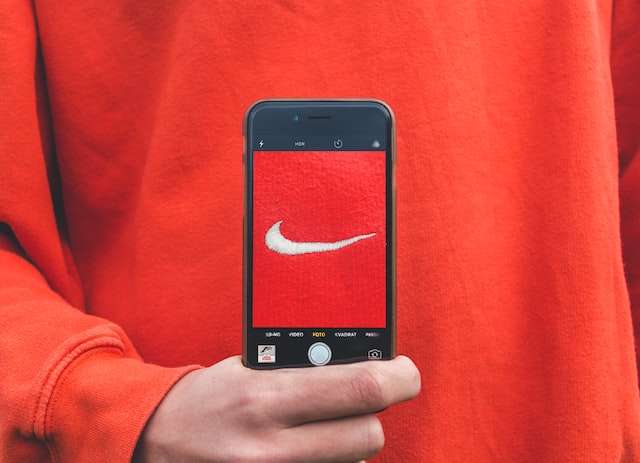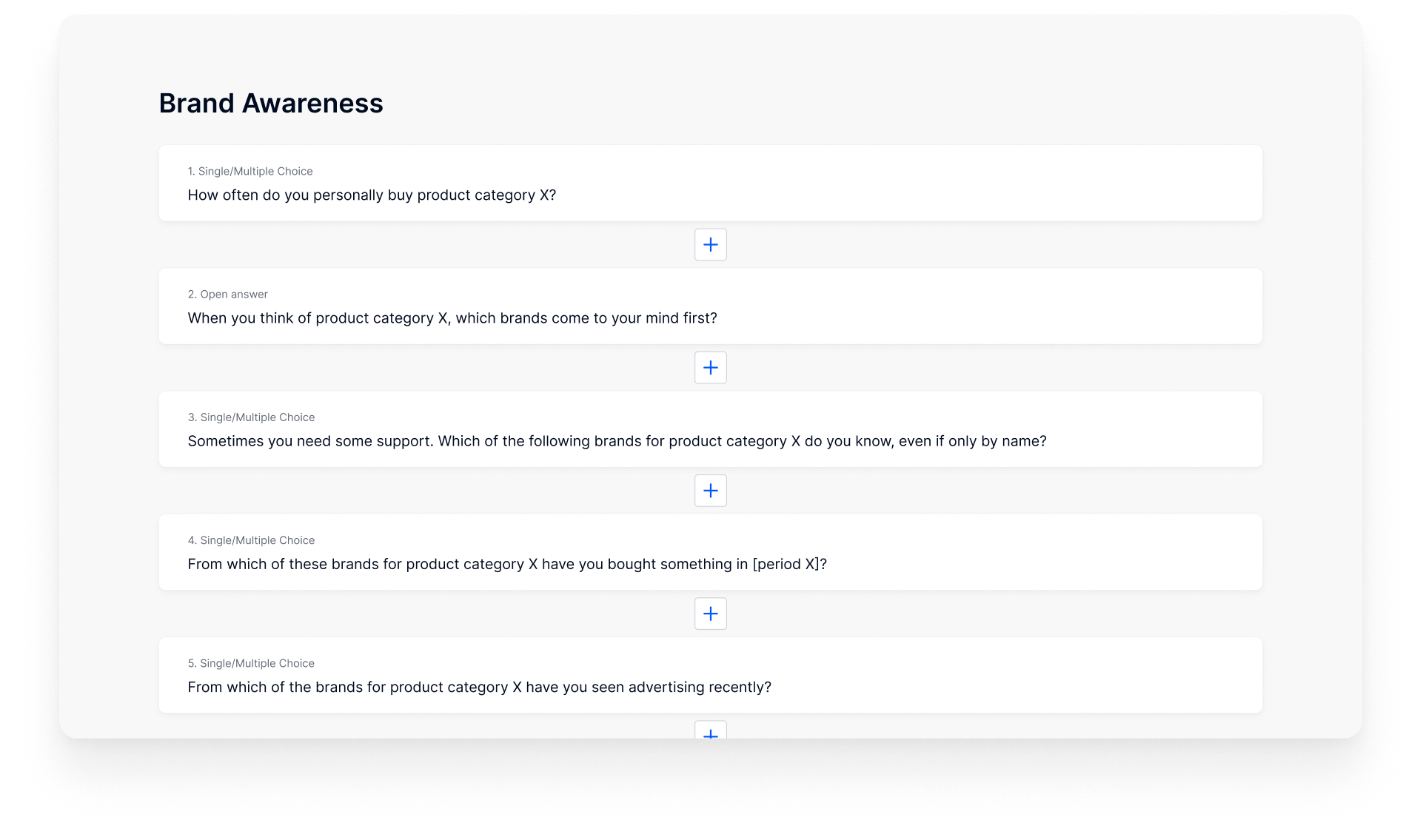Brand Awareness Survey
Appinio Research · 20.10.2022 · 10min read

Content
Introduction
Sportswear: Nike and Adidas. Car brands: Volkswagen, Mercedes, Audi. When naming a product category, consumers know brands associated with it. Often it is the favourite brand, sometimes it is also the brand for which consumers last saw an eye-catching advertisement. The fact that one's own brand is buzzing around in consumers' minds is important for companies. Brand awareness describes the proportion of consumers of a certain group who know a brand.
But how do you know whether your brand is present in consumers' minds? You simply ask them with the help of a survey.
How you conduct a brand awareness survey and why it is so important, we explain below.
Did you know that Appinio is leveraging also a new and innovative method to track your brand? Discover Mental Availability (MA), a revolutionary approach to brand tracking developed by marketing experts Jenni Romaniuk and Byron Sharp.
Mental Availability measures how likely a brand is to come to mind in various buying situations, providing predictive, actionable, and reliable insights.
Key metrics include Mental Market Share, Mental Penetration, Network Size, and Share of Mind. These offer a dynamic and accurate picture of brand health by focusing on Category Entry Points (CEPs), the critical moments when a brand must come to mind, read more about Mental Availability and how it can help you.
If you are interested in this new approach, have a deep dive and listen to our research director Louise Leitsch explaining Mental Availability in detail!
![]()
1. What is Brand Awareness?
Brand awareness measures the level of awareness of a brand in per cent. How many consumers of a certain target group know my brand? How many people remember my brand without thinking about it and how many say they have at least heard about it? Brand awareness indicates how familiar consumers are with a brand.
A brand is an important criterion for consumers when making purchasing decisions, so brand awareness is important in addition to brand image. This does not necessarily mean that consumers should remember the specific brand name. Rather, it is a matter of knowing enough characteristic features of a brand.
2. Why is Brand Awareness Important?
Consumers usually prefer brands that they already know. This is particularly the case with low-involvement products. i. e. everyday products, such as milk, pasta or cleaning agents. Consumers buy those without thinking much about it or asking for too much information. With these low-involvement products, brand awareness is important. Since consumers in low-involvement situations decide quickly, they reach for the brands they already know or have heard of. It is similar with products consumers buy for the first time.
However, high brand awareness is also important for interchangeable products. If the features, quality and price of products from different brands are very similar, then customers will choose goods from well-known brands. This is also the case when a completely new product comes out, since the consumers already trust certain brand. Thus, brands with a high brand awareness have an advantage over competing products from unknown brands or real competitors when it comes to consumers' purchasing decisions.
3. Types of Brand Awareness

Top-of-Mind Awareness
Top-of-mind awareness stands for the brand that comes to consumers' minds first when they are asked about a product category. It is on the tip of their tongue, so to speak, and can be called up immediately. If, for example, somebody asks for smartphone brands and a consumer answers "Apple", then this brand has a high top-of-mind awareness for him or her.
However, a high top-of-mind awareness does not mean that the brand is also the favourite brand or bought most frequently. The brand name is only the one that buzzes through the consumer's head the most.
In a brand awareness survey, the top-of-mind awareness is measured with the help of open-ended questions, such as: "When thinking about sneaker brands, what is the first brand that comes to mind?"
Unaided Recall
Unaided recall (also called "active brand awareness" or "brand recall") describes the proportion of consumers who can remember a particular brand without any reminder. Consumers are asked what brands come to mind for a particular product category or industry. Respondents do not receive information such as pictures or ads. Thus, the brands mentioned as the answer are deeply anchored in the consumers' consciousness and can therefore be easily remembered.
When brand names come up in unaided recall, it means that consumers are familiar with them, have often heard of them and/or may prefer them. That is why they can name them without any effort or support. A certain product category is strongly associated with that brand name. As a rule, consumers can name between three and five brands per product category, rarely more than seven. Therefore, it is the highest goal that the own brand is among these remembered brands.
Unaided recall is also measured with open-ended questions, for example: "If you're thinking of ready-made pizza, what brands do you think of?" Or: "What shampoo brands are you familiar with?" The participants' first answer indicates the top-of-mind awareness. In the brand awareness survey, another question may follow such as "What other shampoo brands can you recall?" if the participants only give one brand name when asked for the first time.
Aided Recall
Aided recall is measured to find out whether consumers know a brand or have heard of it before. This type is also called "passive brand awareness" or "brand recognition". It is about finding out whether consumers recognize a brand when they are approached.
With aided recall, reminders are allowed in a survey question. Consumers are asked whether they know the brands they are told, using closed questions. You can also show them logos or pictures of brands and ask them whether they know the brands or whether they have seen the logos before.
For example: "Have you ever heard of this brand: X?" Or: "Which of the following sneaker brands do you know? Adidas, Nike, New Balance, Converse".
The fact that a brand can at least be recognised by consumers is particularly important when making purchasing decisions at the point of sale, either offline or online. Here the consumer is confronted with a multitude of different brands and has to make a choice. They will very likely reach for the product whose brand they have at least once heard of.
Of course, all three types of brand awareness survey questions can be asked in one questionnaire.
4. Eponyms
If your nose is running, are you asking for a handkerchief or a Kleenex? Do you run a search engine or do you google? Terms like "Kleenex" or "(to) google" are so called eponyms. They became ordinary common nouns which derived from a proper noun, the name of a person or a place.
Eponyms are the peak of brand awareness. These brand names are so well known that they have become generally accepted as a term for a certain product category.
5. Brand Awareness Surveys Measuring Advertising Effectiveness
Anchoring the presence of a brand in the consciousness of consumers is an important goal of advertising. Ideally, after an advertising campaign, more people remember the brand of the product the ad was about. Therefore, it is important in the course of advertising campaigns to check the effectiveness by means of regular brand awareness surveys and brand tracking.
Before launching a campaign, the target audience is asked if they know the relevant brand (pre-campaign evaluation or pre-testing). This can be verified by using one of the three types of brand awareness survey questions. While the campaign is running, consumers of the same target group can still be interviewed and also some time after the campaign (post-campaign evaluation or post-testing).
It is important not to question exactly the same consumers each time. This would skew the results, because once a consumer has participated in a survey on brand X, he or she will naturally be more likely to remember that brand in the next survey. And the reason for that would not be the advertising campaign but the previous survey.
If, in the next survey, more consumers name brand X as an example of a particular product category (unaided recall), or if it is recognized more frequently (aided recall), this is an important indicator that the advertising campaign has been successful.
Want to run your brand awareness study?
Get started in minutes by using our free templates for brand awareness in the Appinio platform.
6. Measuring Brand Awareness with Online Surveys
Digital market research makes it very easy to find out whether consumers know your brand and how strongly it is anchored in their minds. In order to conduct a brand awareness survey, the first step is to create a questionnaire. This questionnaire should contain all relevant questions and meet certain quality criteria for surveys so that you can work well with the results.
You can also use brand tracking to measure your brand awareness constantly or your marketing efforts over the course of a certain campaign. In brand tracking studies, consumers are asked the same questions over and over again so that the answers are comparable. With the help of a brand tracking survey, you can also measure brand attributes and brand loyalty.
Get facts and figures 🧠
Want to see more data insights? Our reports are just the right thing for you!



